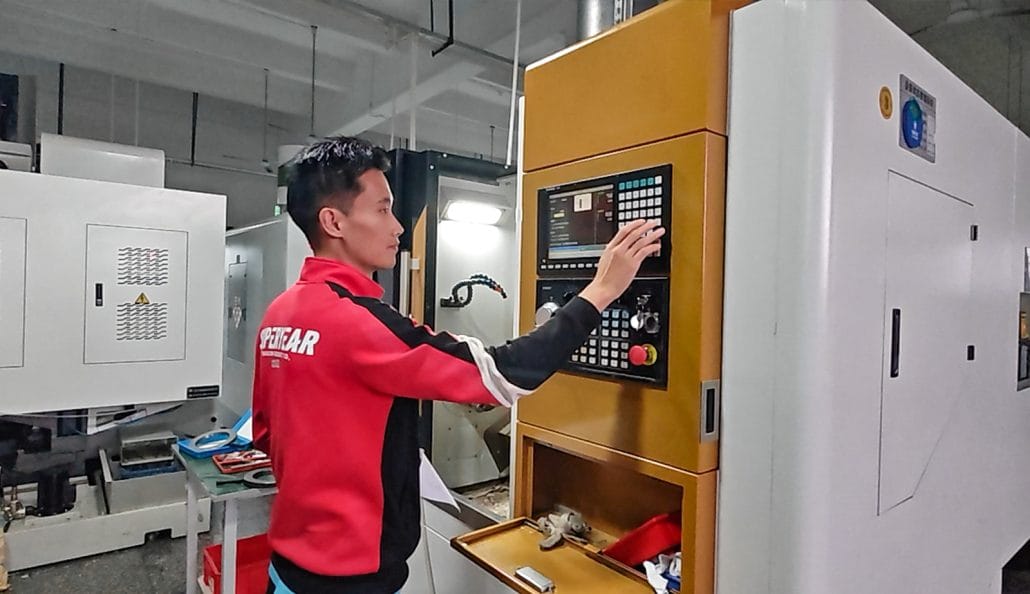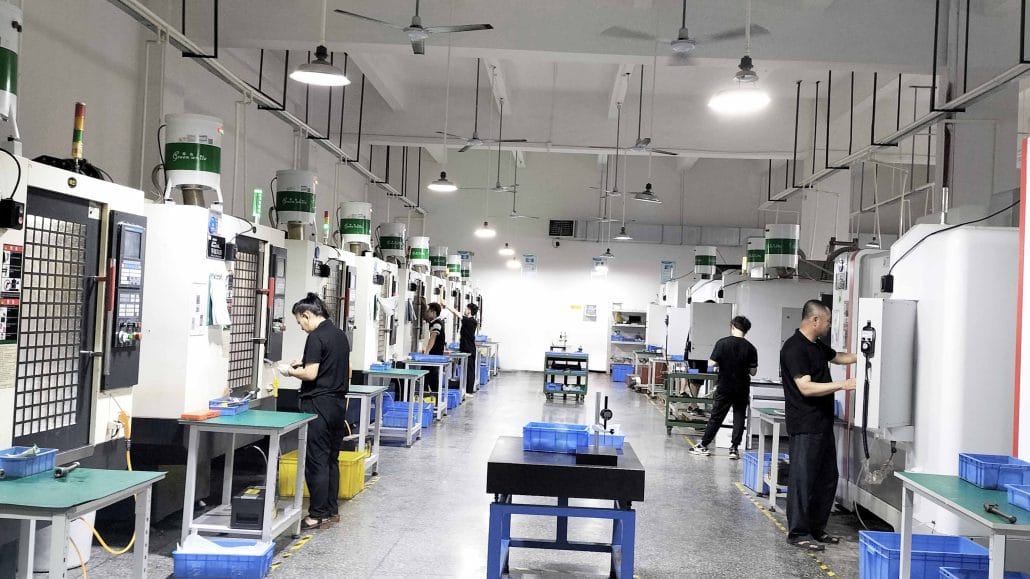Manual turning and CNC turning are indispensable processes in the field of metal machining. CNC turning is an automated machining method, while manual turning is a manually controlled machining method. Although both methods can be used to manufacture precision parts, choosing the correct machining method is crucial for your project.
If your project requires CNC turning, you may face the choice of manual turning or CNC turning? Both of these methods have their own advantages and disadvantages, and you need to carefully consider your project requirements and budget to choose the most suitable method for you
In this article, Longsheng Technology will introduce the differences between manual turning and CNC turning, as well as how to choose a suitable method for your project. Please continue reading.
What are manual turning and CNC turning?
Comparing manual turning and CNC turning starts with understanding their working principles.

Manual turning
Manual turning is a manufacturing process used to manufacture various mechanical components. Manual turning can be made from various materials, from plastic to metal and other metal alloy materials.
Manual turning technology requires a high level of technical proficiency and a meticulous spirit, but this machining technology can provide engineers with greater freedom and control.
The principle of manual turning is to rotate the workpiece on the lathe and use the tool to process the workpiece. In manual turning, the control of the lathe is based on manual input. Manual turning technology requires the right manual to grip the tool and the left manual to use a combination of machine tool control levers. In the process of manual turning, good manual eye coordination and extremely keen observation are required.
Manual turning has certain limitations. Firstly, manual turning requires highly skilled operators who possess a wealth of experience and skills to accurately control the process. Secondly, in terms of large-scale production, manual turning has relatively low efficiency and higher costs.
Manual turning is widely used in various industries. For example, in the aerospace industry, manual turning is a standard process for manufacturing engines and aviation components. From manufacturing automotive components to steel production, manual turning technology is required.
CNC turning
CNC turning is a computer numerical control technology used to cut materials on rotating workpieces. It uses programming language to guide the machine in cutting on the surface of parts, using rotating tools to process along specific paths. Due to the ability of computers to control the position and speed of tools, precise cutting and high-precision geometric shapes can be achieved.
Compared to traditional manual turning, CNC turning can process various complex shapes more quickly and conveniently. The principle is to control the cutting tools on the machine bed through a computer for precise cutting and machining. During this process, CNC lathes can automatically adjust the depth and speed of the cutting tools to meet different machining requirements and accuracy standards.
CNC turning has a wide range of applications and can be used for machining various materials. At the same time, it can also achieve different types of machining, including turning, cutting, milling, and drilling. In industries such as aerospace, mechanical manufacturing, automotive manufacturing, electronics, etc
conclusion
As mentioned above, manual turning is a turning method that controls the shape and size of products through manual operation. CNC turning is a process that uses computer numerical control machine tools. Generally speaking, the advantages of manual turning are relatively simple and easy to use, low cost, and can handle many simple shaped products. It is very suitable for people who are just beginning to learn and use mechanical machining. The disadvantage of manual turning is that it requires manual control, resulting in low efficiency for complex shapes or products that require extensive machining.
In contrast, CNC turning is an efficient and high-precision machining method, which has great advantages for objects that require mass production or products with complex shapes. However, CNC lathes have a higher cost and require a stronger level of technology.
To learn more about the difference between cnc turning and other machining methods, please click the link [Cnc Turning And Milling]

What are the advantages of manual turning compared to CNC turning?
In addition to the comparison of working principles mentioned above, you can also compare manual turning and CNC turning by understanding their respective advantages to determine which is more suitable for your project
Advantages of CNC turning
The advantages of precision CNC turning are as follows:
High precision and repeatability capability
CNC turning has very high accuracy and repeatability capabilities, making it an ideal machining method. Due to the control of computer programs, machine tools can cut at highly precise positions, ensuring the consistency of part size and shape. In addition, for the same workpiece, we only need to write a program once, and the machine tool can repeatedly process the same product. This repetitive ability greatly improves production efficiency and reduces the possibility of manual errors.
Cost savings
CNC turning saves a lot of manual operations and preparation work in the production process, reduces labor intensity, reduces production error rates and scrap rates, and thus reduces production costs. In addition, CNC turning is also more energy-efficient, enabling better control of energy consumption such as electricity, making enterprises more environmentally friendly and energy-saving.
High precision
CNC turning can produce complex parts in a very short time, making it very suitable for industries with high requirements for part accuracy and quality, and ensuring high-precision dimensions and dimensional tolerances. It can ensure consistency in repeated machining by changing programming, and can manufacture parts of different sizes, shapes, and complexities using a set of programs
High flexibility
CNC turning can change the machining program and parameters at any time without changing the machining equipment, and can be produced in a short period of time. Compared with traditional turning, it can better respond to changes in market demand and support small-scale, fast, and multi variety production models.
advantages of manual turning
Although CNC turning has the ability to produce customized precision components or complex shaped workpieces, it also has its own value in manual turning. The following are the advantages of manual turning.
Selection controllability
Manual turning and milling can be used for various materials and shapes. The manual turning process can be customized for different material types and shapes, whether it is metal, plastic, wood, glass, etc., all of which can be processed with appropriate tools, skills, and techniques. This means that manufacturers can produce products of different materials and shapes, thereby expanding their customer base.
environment protection
Compared to machine lathes, manual lathes do not require electricity or fuel, thereby reducing their impact on the environment. Therefore, it is also a sustainable process.

conclusion
After comparing the advantages of the above two processes, I believe everyone already has their own choice. Although manual turning may not be as fast and efficient as CNC turning, it still has its advantages. If you need to produce a large number of complex workpieces with sufficient budget, CNC turning is a better choice. If you need to handle small batch production and personalized production needs, and the budget is relatively limited, such as machining complex surfaces and small batch production, manual turning is a good choice.
For more information about cnc machining process, please click the link [9 Different Types Of CNC Machining Processes]
benefits of CNC lathe machines for prototype production
When evaluating which one is better, manual turning or CNC turning, here are two CNC lathe machines that allow you to choose machining projects
Vertical CNC lathe
Vertical CNC lathes can produce very complex components, which may include cams, gears, and threads. This type of lathe can also quickly change the tool and adjust the depth and position of the tool as needed. This makes vertical CNC lathes an ideal choice for producing small batch, high-precision components.
Unlike manual turning, vertical CNC lathes can seamlessly perform cutting and machining operations through programming, thereby maintaining the consistency and accuracy of the workpiece.
Horizontal CNC lathe
Compared with vertical CNC lathes, horizontal CNC lathes are suitable for the production of large workpieces, such as automotive parts, aviation components, etc. Its structure is more stable, and details such as height and angle can be freely adjusted to ensure accuracy.
When making prototypes, horizontal CNC lathes can process various materials, such as hard materials such as steel, aluminum, plastic, and copper. This makes it very suitable for producing industrial grade prototypes.
Compared to manual turning, horizontal CNC lathe machines have three significant advantages: stability, efficiency, and high accuracy
conclusion
When choosing a CNC lathe, you should make your choice based on your specific needs and the type of prototype you want to make. If you need to make small, high-precision components, then a vertical CNC lathe is a good choice. If you need to make large prototypes and molds, a horizontal CNC lathe is a better choice.
No matter which type of CNC lathe you choose to create a prototype, it will be a very worthwhile investment tool. Compared to manual turning, using a CNC lathe machine can greatly improve your production efficiency, save you time, and produce high-quality components and prototypes.
Work Application of manual Turning and CNC Turning
manual turning is usually applied in the following scenarios:
1.In situations where the short-term demand for machining is high and the demand for conventional machining is not high.
2.Some non-standard parts machining . Manual turning can flexibly cut workpieces of different shapes and sizes, achieving precise machining results.
3.For some non fixed quantity and non targeted parts machining.
CNC turning is suitable for the following situations:
1.Parts machining occasions that require mass production of standard parts machining;
2.machining of parts with inherent technical requirements or high machining difficulty;
3.machining of parts with high requirements for machining accuracy and quality.
cost difference between manual turning and CNC turning
In this section, we will show you the cost differences between manual turning and CNC turning. The main cost differences are as follows:
material cost
There is not much difference in material cost between manual turning and CNC turning, as both require materials to complete the machining. Regardless of the machining method used, the price of the material remains unchanged. However, CNC turning can provide higher accuracy, which means that if CNC turning is used, less material may be wasted. This can save some costs.
Machine cost
There is a significant cost difference between manual turning and CNC turning machines. CNC turning requires specialized equipment for machining, while manual turning does not require additional equipment and only requires manual operation. Therefore, the equipment cost of CNC turning is significantly higher than that of manual turning. Nevertheless, CNC turning has higher efficiency and significantly improved production efficiency compared to manual turning.
Labor costs
manual turning requires more manual labor participation, therefore more personnel salaries need to be paid. CNC turning requires a small number of operators to control the machine. Compared to manual turning, CNC turning can better control labor costs.
conclusion
The cost of CNC turning is higher than manual turning, but when dealing with tasks that require a large amount of machining, CNC turning can save a lot of time and labor costs. Therefore, in long-term operation, the cost advantage of CNC turning will be reflected. It can be said that choosing manual turning or CNC turning depends on the nature of the machining task and the balance between reducing costs and improving efficiency.
If you would like to learn some tips about [CNC Machining Cost], please click on the link.

Application of CNC Turning
Some of the main industries commonly used for CNC turning machining are:
Aerospace and Automotive Industry
In the aerospace and automotive industries, CNC turning can produce high-precision and high-quality mechanical parts, such as pipelines, bearings, pumps, engine components, fuselage components, and satellite components.
Electronics industry
In the electronics industry, CNC turning technology can be used for the manufacturing of electronic products, such as hard drives, chips, and LED lights.
Medical devices
CNC turning can provide high-precision CNC machining services in the medical industry, making it an indispensable part of the medical device field. For example, it can manufacture highly precise deformed metal components, such as artificial limbs and organs.
Manufacturing custom parts
In some cases, manufacturers may need to customize some parts that may not be available in the market. In this case, CNC turning technology can provide manufacturers with production solutions that can be precisely controlled. CNC turning can manufacture parts that fully meet the manufacturer’s requirements.
If you would like to learn some tips about [CNC Turning Application], please click on the link.

Exploring CNC Turning
If you are considering using CNC turning to manufacture products, you can choose Longsheng Technology’s customized online CNC machining services. We are a professional CNC turning service provider. With advanced equipment and technology, we can provide high-quality component manufacturing services.
Unlike other mechanical manufacturing companies, Longsheng emphasizes good communication and cooperation with customers. Our professional team will respond to customers’ needs as soon as possible, providing you with the best solution whether you need small batch customization or mass production. Our standardized management and strict quality control ensure that all products meet the highest standards.
Of course, Longsheng not only provides CNC turning services, but also other mechanical machining services, such as cnc milling, drilling, etc. Our team has extensive experience and can handle various mechanical manufacturing challenges to ensure customer satisfaction.
For more information about our CNC turning services, please contact us.
FAQ
This depends on your product requirements and budget. manual turning may be more suitable for small batch products that require personalization, while CNC turning is suitable for large-scale production. Manual turning requires more manual operations, so the cost may be higher.
For manual turning, you need a lathe and manual tools such as knives and tweezers. For CNC turning, you need CNC lathes and computer software. Ultimately, the choice of machining method depends on your needs and budget.
CNC turning is more precise because it is not affected by the skill level of the operator. On the other manual , manual turning may have errors as operators need to manually adjust the position of tools and workpieces.


